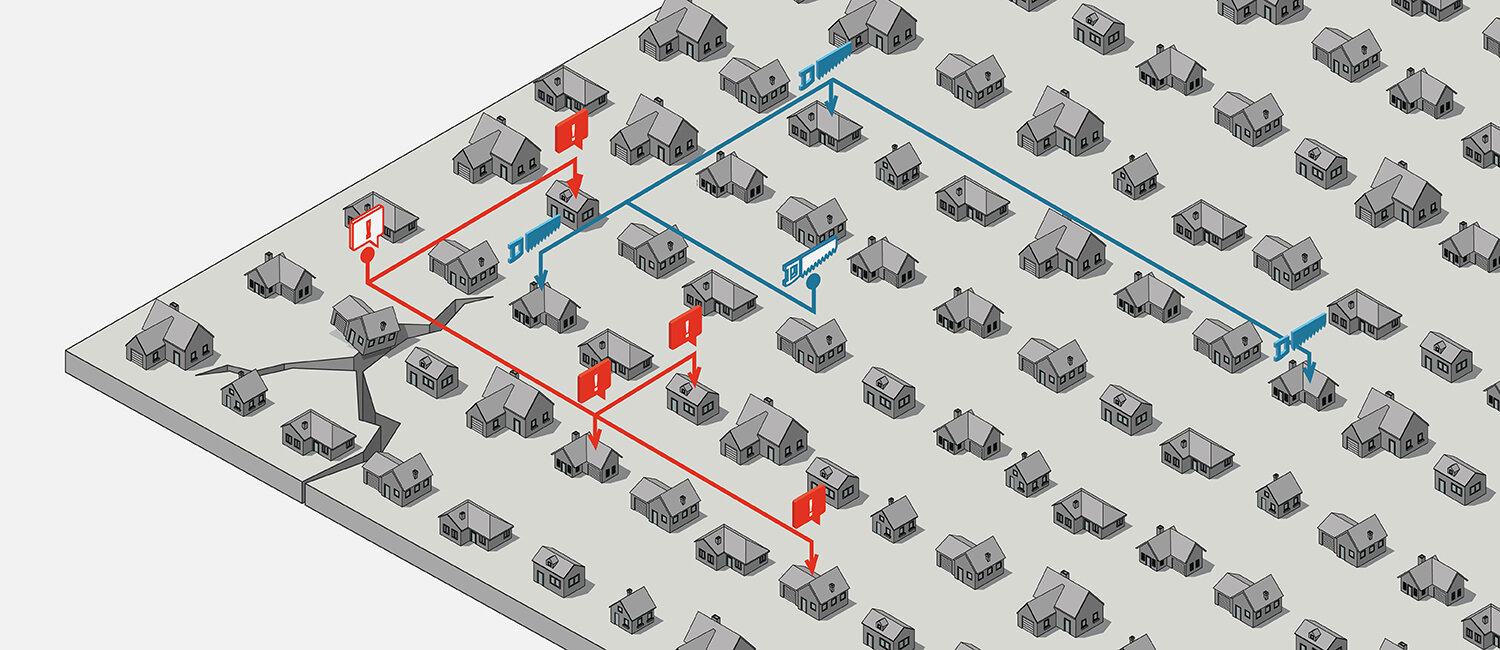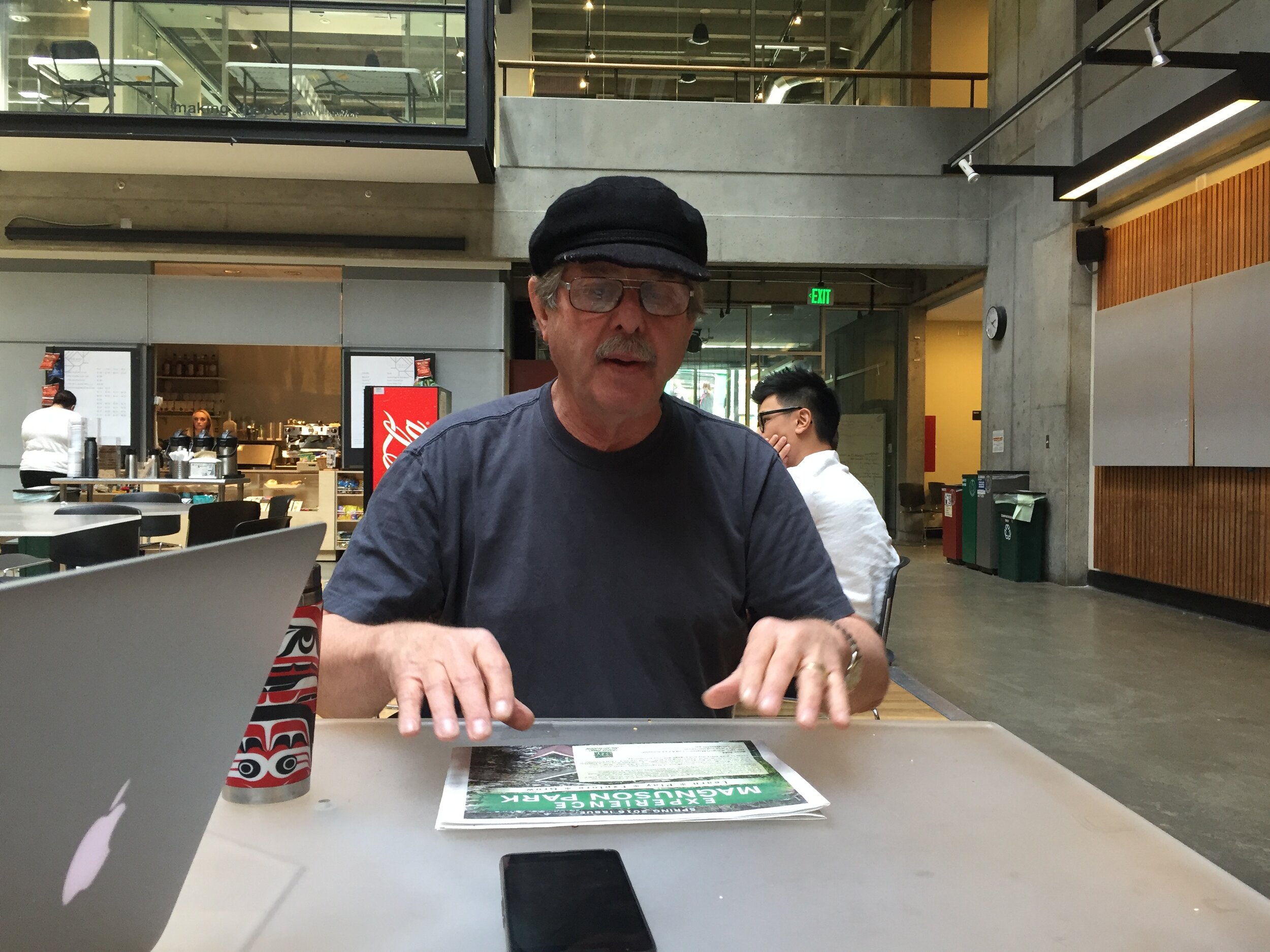
Ping
This project was about answering one simple question:
How can we reduce the negative impact of a natural disaster?
I was part of a 3-person team that researched, prototyped, tested, and designed Ping, an app that allows people to ask questions and share resources before and during crisis events, building community resilience through location-based chat.
VIDEO
Ping - because together, we’re stronger
TEAM
Adam Riddle, Hyun Kim, Lyle Klyne, Advisor - Andy Cargile of SMART Technologies
Research.
When you pick a topic like natural disasters to research, it becomes important to constantly monitor your focus against the initial research questions you've outlined. The topic is incredibly broad with miles of articles written about every aspect of it, so getting lost in the weeds only takes a minute. For our team, we focused on breadth over depth for research techniques because we wanted to understand all aspects of the topic from expert interviews, to articles, to funding, to competitive analysis of existing solutions. By learning about the 5 phases of natural disasters, we choose to specifically focus on response because it has a greater potential for improvement and a more sustained impact.
RESEARCH QUESTION:
How can we reduce the negative impact of a natural disaster?
We were able to synthesize months of research and came up with 4 key insights to test against our research question, which are:
1. One of the only guarantees after a natural disaster is that survivors and volunteers will come together to help each other out.
2. Locals are more suited to respond than governments and external relief organizations because of their knowledge of the area or specialized skills.
3. Even though people want to help, and are capable of doing so, sometimes they don’t have the right information to do so effectively.
4. People improvise and use everyday digital tools that they have used before in response efforts.






Ideation.
The most important part of ideation for us, was exploring as many possibilities as we could collectively think of. This became one of the most collaborative parts of the entire project as we structured our ideation sessions as timed, fast paced sketching activities. The most successful were our group brainstorming activities and storyboarding.
BRAINSTORMING
We spent 15 minutes individually sketching solutions for each of the design prompts. At the end of each round we shared and explained the solutions. With each idea that was generated, the creator would say a one sentence description of what it meant. This not only helped others not to recreate the same idea, but it allowed others to build on that idea or take a different twist on it. After completing all the initial rounds of ideation we had a total of 200 rough design directions. We then grouped these into themes based on solution type to understand the breadth of our ideas. Finally we sketch a wildcard round to document any last minute concepts before moving on. As a group we then voted on the strongest or most interesting concepts to move forward. These concepts were again grouped into themes which were then further developed in storyboard form.
STORYBOARDING
We narrowed down over 200 ideas into just the top 13, and created single page write-ups. For each concept, there was a brief description, overview of the interaction model, short storyboard documenting its use, the problem it solves / what it does differently than existing technology, and how it works from a technical standpoints. Out of these ideas, we moved forward with just 3 to explore more in depth.






Prototyping.
We created three prototypes to evaluate our research questions and hypotheses. These prototypes addressed what we considered to be the most essential attributes of our design; privacy and trust, tools for collaboration, and group formation. Because we couldn't simulate an actual natural disaster, we looked for opportunities in everyday life that would mimic situations that also happen during disasters.
ACTIVITY 1 - PROFILES (TRUST vs PRIVACY)
Is there a balance between information that people are comfortable disclosing and information that is required to evaluate trustworthiness? During the prototype evaluation we presented participants with example profile pages with varying levels of information and ask them to rate the profile’s trustworthiness based on a variety of actions. In a second phase, we wanted to know how comfortable they would be if the profile was their own and shared with the public. In the final phase, all attributes of the full profile are broken apart and the participant is asked to rank how valuable this information is to them.
ACTIVITY 2 - TOOLS FOR COLLABORATION (GROUP CHAT)
Do individuals feel more comfortable requesting favors from strangers in close proximity to strangers that are further away? We conducted a behavioral prototype to answer this question. In this prototype, we had three participants (two women and a man ages 23-31) go through a time-sensitive scavenger hunt where they had to find resources in order to survive a mock disaster. We used Slack so simulate the location-based groups, having channels for different radiuses ranging labeled as “five minutes away,” “30 minutes away,” etc. We also included a group titled “nearby friends” allowing participants to access people they had already connected with.
ACTIVITY 3 - GROUP FORMATION (CAMPING TRIP)
We planned a group-based planning and supply activity. A group of 4-6 people was asked to coordinate a camping trip. In the pilot version of the activity, the group was asked to complete this task with one member acting as the group leader. The leader was given a short checklist and asked to document the planning process using pen and paper.








App design.
A mobile application was chosen for the final solution for Ping as mobile phones are nearly ubiquitous. In our problem space, we wanted to allow as many individuals to benefit from our solution, and through interviews and secondary research we found that cellular networks are surprisingly resilient. In addition Bluetooth technology that is included in most phones can be leveraged as a fall-back to connect devices when cellular connectivity is compromised.
Our solution is a mobile communication application designed to support survivors in an urban environment before and during a crisis event. Ping allows people to ask questions and share resources, building community resilience through location based chat.
DESIGN PRINCIPLE 1 - REDUCE NOISE
Incorrect, repeat, and irrelevant information, also known as noise, commonly occurs in the wake of a disaster. Ping deals with noise in multiple ways. Communication is scoped to specific locations so that discussions are limited to within an area or neighborhood. Although communication through Ping is synchronous and conversational, messages of importance can be pinned. The ability to pin items is an attempt to reduce repeat information.
DESIGN PRINCIPLE 2 - STREAMLINE ORGANIZATION
Although people come together to volunteer and offer aid in times of crisis, they often do so in an disorganized fashion. This can result in extreme mismatches of donations to need in type and quantity of donations. The list feature can used to help organize donations and generally for resource sharing. Lists can be created in any chat thread and help streamline supplies through a simple interface.
DESIGN PRINCIPLE 3 - SITUATIONAL AWARENESS
Situational awareness is one of the top priorities after a disaster and is necessary to prevent further damages and loss. Due to the chaotic nature of disasters and disruptions of infrastructure, there are additional difficulties in getting up to date information. Through our research we found that disaster survivors had difficulty knowing which stores were open to get supplies they needed. TJ McDonald of the Seattle Office of Emergency Management remarked that situational awareness is especially low in place that have the most damage and need the most aid.




Graphics.
Our goal for Ping was to make an app that works for various levels of urgency, on various levels of technology. In order to make the idea possible, we not only had to design the system, we also had to design the story around what we were trying to do. I've been fortunate to work with amazing teammates, and without their hard work and contribution, the story of Ping couldn't be told. We hand built all the graphics, did all the branding, and created this delicate story around instances of tragedy. Click the video below to see Ping in action.









